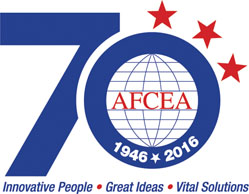Different Wars Change Signals
 This is the last installment in a series of interviews with signaleers, one for each of SIGNAL Magazine’s seven decades, to commemorate AFCEA International’s 70th anniversary.
This is the last installment in a series of interviews with signaleers, one for each of SIGNAL Magazine’s seven decades, to commemorate AFCEA International’s 70th anniversary.
1946-1955
Flush from victory over two of the world’s most menacing dictatorships, the U.S. government raced to dismantle the most powerful military in the world almost as fast as it was built up. By 1949, U.S. defense spending was only 4.8 percent of the country’s gross domestic product, down from 37.5 percent in 1945, the final year of World War II. Then, in June 1950, the Korean War erupted, and the United States remobilized to confront a new threat. Four years earlier, a group of electronics and media leaders had established the foundation of an organization designed to continue the communication between government and the electronics industry that had played such an important role in contributing to force superiority in World War II. That organization became AFCEA, and the need for improved two-way communication between government and industry became apparent quickly.
In some ways, Dan Carvalho is a living example of AFCEA’s creation, development and evolution. Carvalho served in the Army Signal Corps in World War II and even joined the American Signal Corps Association—one of AFCEA’s progenitors—during the war. Afterward, he was on active duty in Japan when he found himself thrust into combat with the onset of the Korean War. Carvalho landed at Wonsan shortly after the 1950 U.N. forces counterattack at Inchon sent the North Korean army fleeing back across the 38th parallel toward the Yalu River. He experienced the Chinese invasion that drove the U.S. 8th Army and the 1st Marine Division back south over the rugged hills of the peninsula during one of the coldest winters on record. And he saw firsthand how some of the signal equipment that helped win World War II was not nearly as effective in the Korean terrain.
“Our systems [in Korea] were so obsolete. It was terrible,” Carvalho relates. “I’ve never seen such bad communications. We had hardly anything—we didn’t have half the equipment [we needed].” Soldiers relied heavily on the EE-8 telephone, which required cranking to initiate communications that were poor in quality. “Most of the time, you could almost yell louder than you could receive,” he says.
Conditions were difficult in the hilly terrain. Troops had no winter clothes, only regular uniforms and boots that provided little comfort as they battled against temperatures as low as 20 degrees below zero Fahrenheit. Soldiers looked forward to receiving newspapers from home because they could roll them up and wear them under their clothes as insulation, Carvalho recalls. Meanwhile, Chinese troops continued to swarm over the hills “like ants” as they attacked U.S. Army and Marine forces relentlessly.
Many communication systems were set up in the back of 2.5-ton trucks. A gasoline-powered potbelly stove in the truck would provide enough heat to keep the equipment functioning in the harsh cold. Generators that powered communications gear also ran on gasoline, so when they ran out of fuel, communications were lost.
The Army began to use microwave communications systems, but they were so heavy that soldiers could not carry them alone. Carvalho explains that they bartered with local Korean civilians—usually offering a couple of packs of cigarettes or candy bars—to carry the gear up to the top of a hill so the soldiers could establish line-of-sight communications. The Koreans used a centuries-old carryall known as an A-frame backpack to tote the modern electronics gear.
The civilians were not always so helpful, Carvalho relates. Many times, as the Army moved forward, the locals would cut the soldiers’ trailing cables and strip them of their rubber to lash together their A-frames. “They really messed us up with our communications,” he notes. “We had a lot of bad times. Most of the time, we had to run a messenger back and forth between the divisions and the signal company.”
The military applied lessons learned in the early part of the Korean War to improve communications during later periods of the conflict. By 1955, two years after the war ended, military communications were much better, Carvalho offers.
In addition to being a signaleer in combat, Carvalho worked as a cryptologist in Korea, at Fort Shafter, Hawaii, and at the Pentagon, where he serviced related gear aboard Air Force One. Retiring as a senior noncommissioned officer after 20 years of service, he can include among his many achievements being a founding member of the AFCEA Hawaii Chapter in 1953.
There is no comparison between today’s military communications systems and those he struggled with in the early 1950s, Carvalho declares. “You can’t beat them now,” he says.



Comments